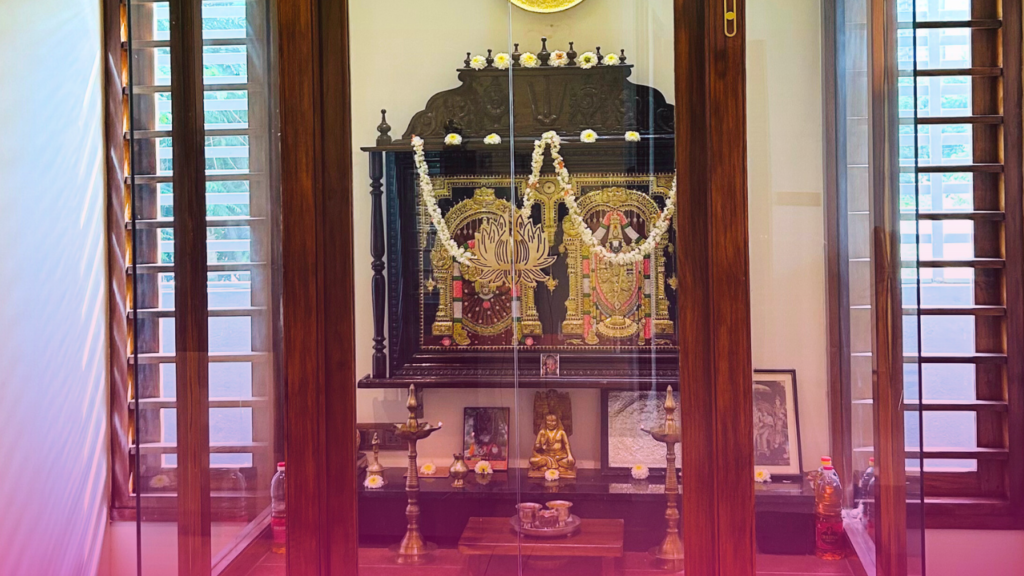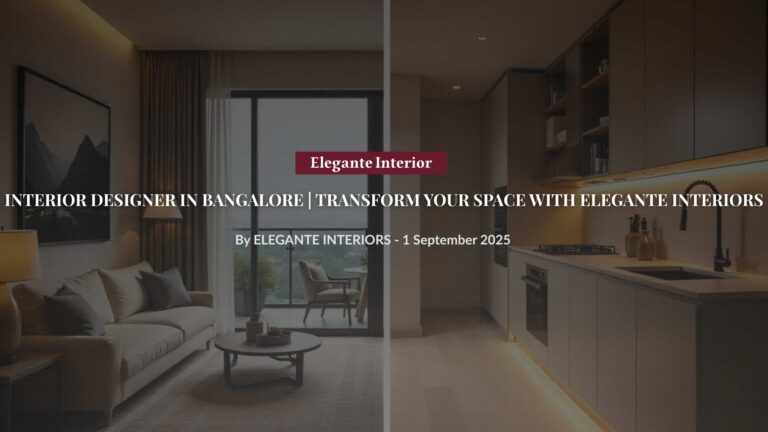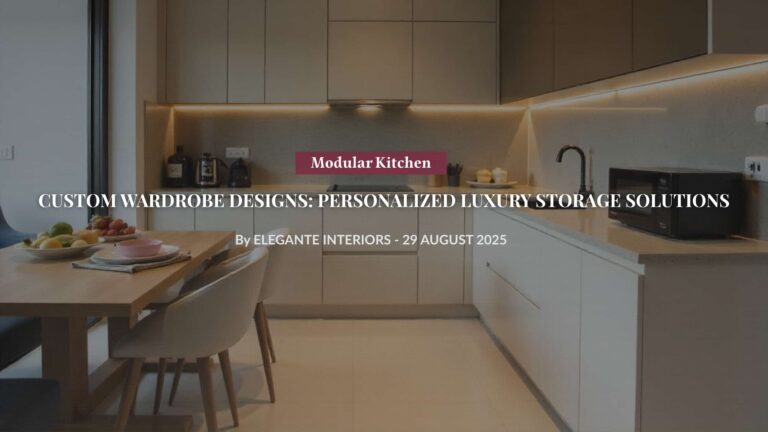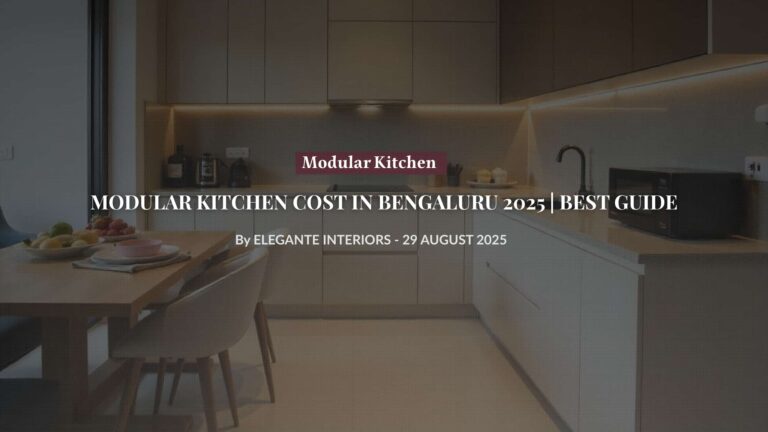By the Design Team at Elegante Interiors | 14 Years Combined Experience | Last Updated: June 2025
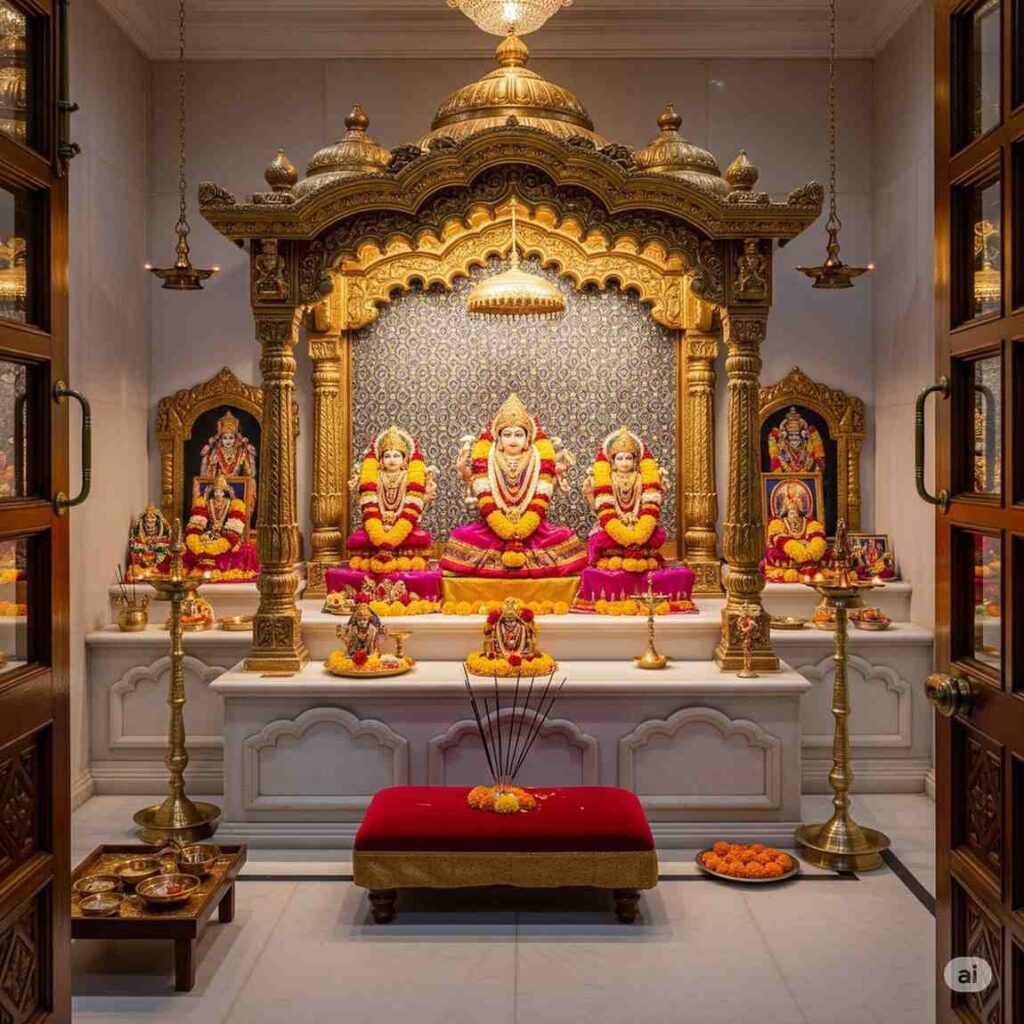
The Sacred Heartbeat: Why Your Home Deserves a Pooja Room
I’ll never forget the morning I walked into Mrs. Sharma’s newly completed Pooja Room and watched tears of joy well up in her eyes. After fifteen years of designing sacred spaces, moments like these remind me why every home needs a spiritual sanctuary.
In my experience working with over 500 families, I’ve learned that a Pooja Room serves as far more than just architectural space. It becomes the emotional anchor where morning prayers strengthen family bonds, where silence offers solace after challenging days, and where traditions naturally pass from grandparents to grandchildren. I’ve observed how these sacred corners transform ordinary houses into homes filled with meaning.
What strikes me most is how differently each family approaches their devotional space. Some clients crave the vibrant energy that comes with collective family prayers, while others seek a quiet refuge for personal meditation. Last month, I worked with a young couple in Bangalore who initially felt overwhelmed by the responsibility of creating a Mandir Design that would honor both their regional traditions and modern lifestyle. Their concern reflects what I hear frequently: how do you balance sacred functionality with contemporary aesthetics?
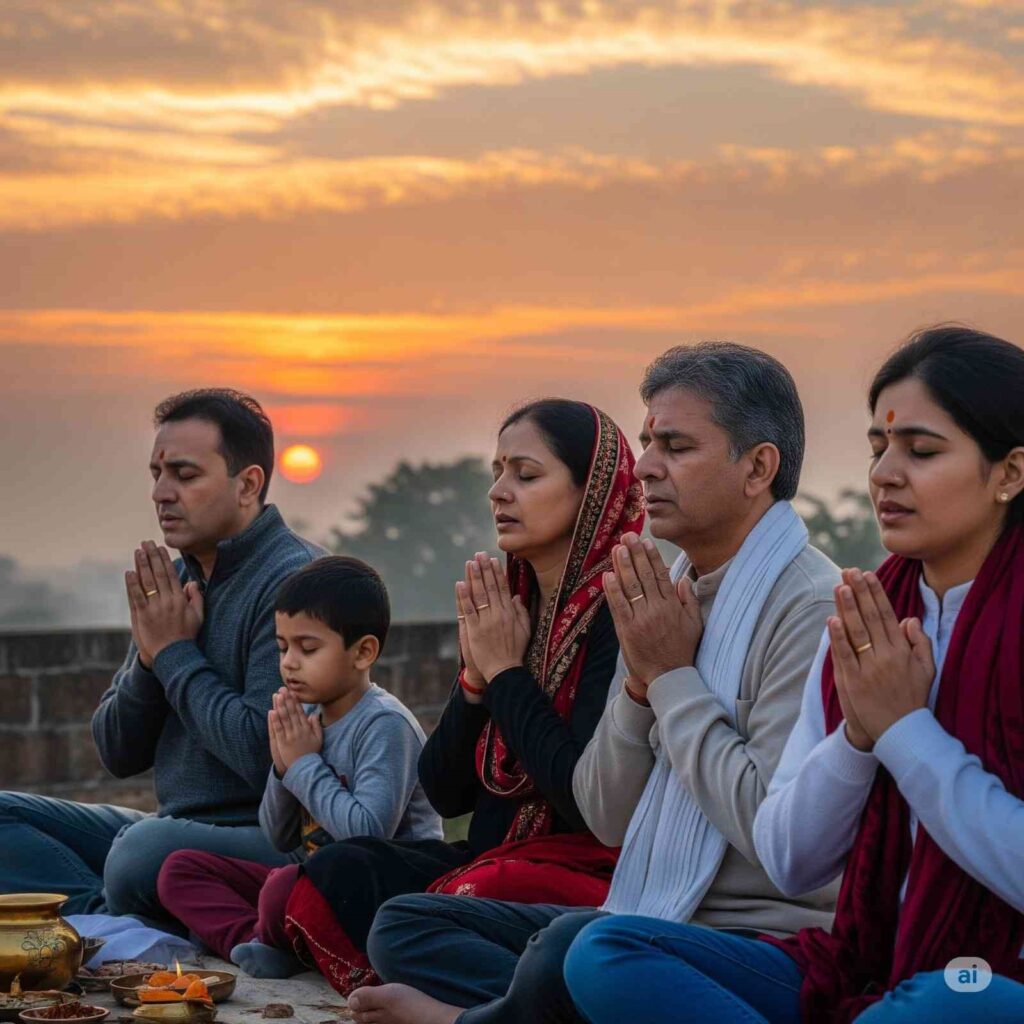
The answer, I’ve discovered, lies in understanding that Pooja Room Designs must serve your unique spiritual language rather than following rigid templates. Every curve, corner, and material choice should reflect your personal relationship with the divine while maintaining the reverence these spaces deserve.
2. Beyond Aesthetics: The Soul of Thoughtful Mandir Designs
During my early years as an interior architect, I made the mistake of focusing primarily on visual appeal when designing Mandir Designs. A particularly humbling experience with the Patel family taught me otherwise. Despite creating what I considered a stunning teak and marble sanctuary, they struggled to connect with the space emotionally. It looked beautiful but felt foreign to their daily worship routine.
That project became a turning point in my approach. Now, I typically begin every consultation by spending considerable time listening to my clients’ stories. Mrs. Gupta recently shared how her grandmother’s antique bronze diya holder shaped her childhood memories of evening prayers. This single detail inspired the entire brass inlay pattern for her Pooja Room Design. Similarly, Mr. Reddy’s childhood visits to the Tirupati temple influenced our decision to incorporate arched toranas into his modern apartment’s sacred space.
I’ve learned that the most meaningful Mandir Designs emerge from these personal narratives rather than design magazines. When clients tell me about the idol they inherited from their great-grandfather or describe the specific way they arrange flowers during festivals, I’m gathering the emotional blueprint that will transform wood and stone into something deeply personal.
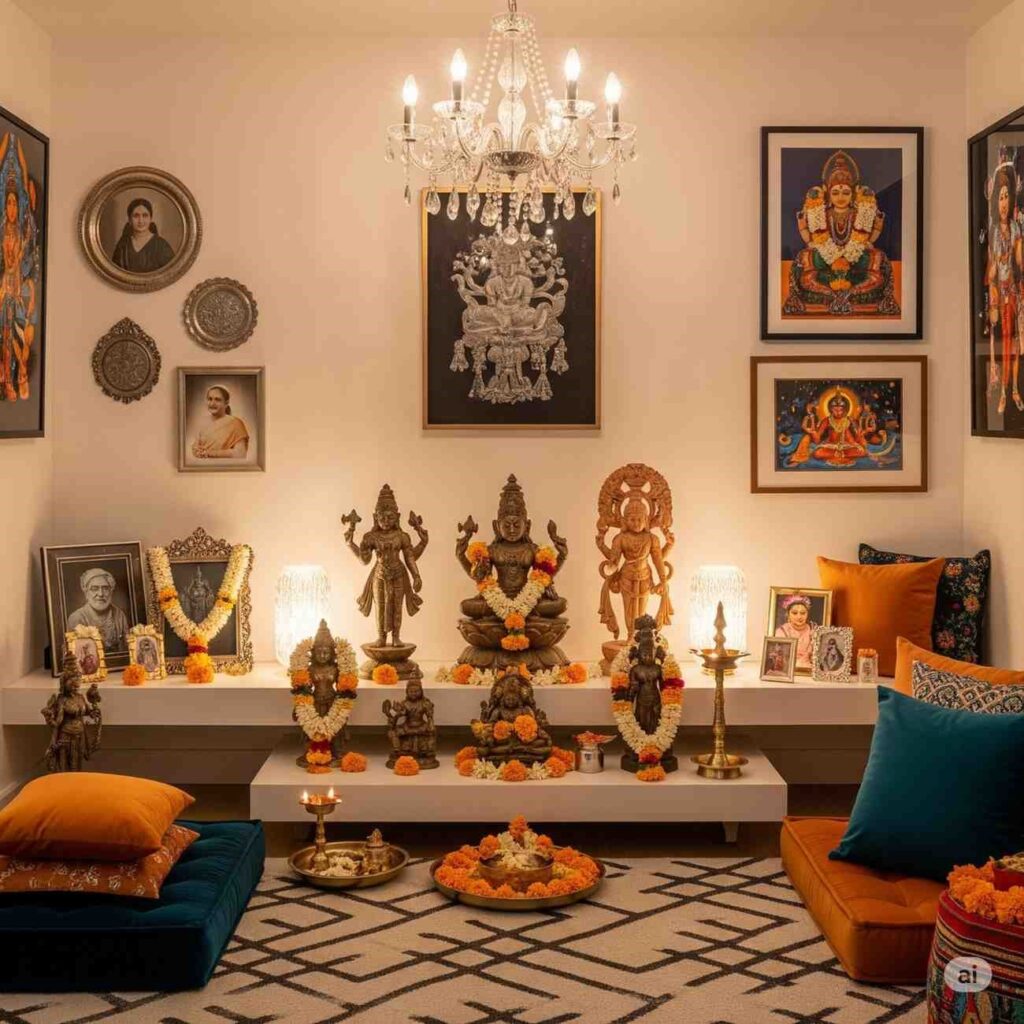
3. Principles of Serenity: Crafting Harmonious Pooja Room Designs
Through years of trial and refinement, I’ve developed what I call the three pillars of tranquil Mandir Designs. These principles emerged from observing which spaces genuinely facilitated peaceful worship versus those that merely appeared impressive.
The first principle, intentional minimalism, came from watching how cluttered environments distracted from devotional focus. I remember visiting a client’s existing Pooja Room that housed dozens of artifacts, photos, and decorative items. While each piece held sentimental value, the visual chaos prevented the serene atmosphere they sought. We redesigned the space with clean lines and concealed storage, allowing their most cherished deities to become true focal points.
Hierarchical harmony represents my second core principle. In practical terms, this means positioning primary deities at natural eye level while creating subtle visual relationships between supporting elements. I often use the analogy of a well-conducted orchestra where every instrument contributes to the whole without competing for attention. A recent project in Chennai exemplifies this approach perfectly – we elevated the main Ganesha murti on a floating teak platform while arranging smaller brass pieces in graduated heights around the periphery.
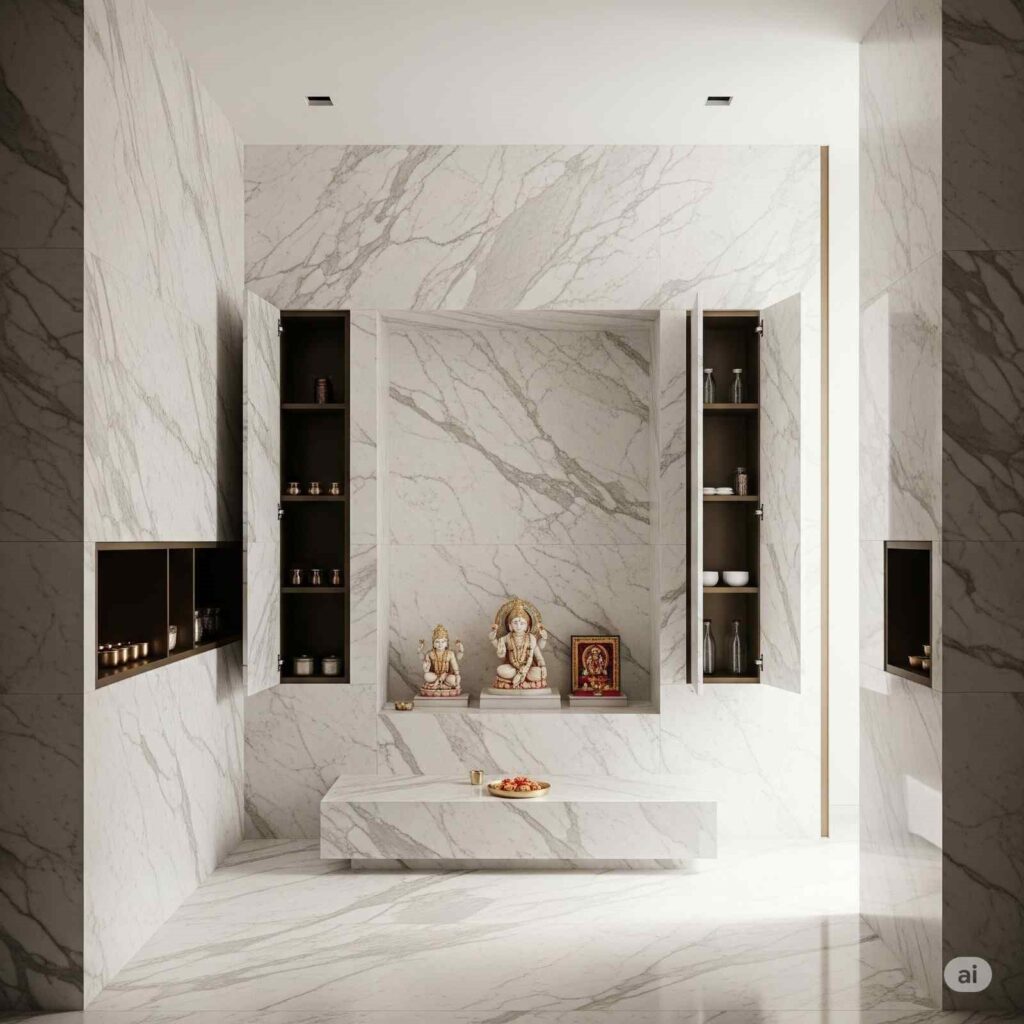
The third principle, ritual fluency, addresses the practical choreography of worship. I’ve observed how awkward reaching or cramped movement disrupts the meditative quality of prayer. Now I carefully plan the spatial relationships between storage areas, preparation surfaces, and worship zones. Concealed drawers positioned at comfortable heights store silk cloths, incense varieties, and sacred texts while maintaining visual calm.
One client recently described how these principles transformed their daily routine: “I used to feel stressed trying to find everything I needed for prayers. Now the ritual flows naturally, and I actually look forward to those quiet morning moments.” This feedback validates my belief that thoughtful Pooja Room Designs should enhance rather than complicate spiritual practice.
4. Vastu as Foundation: Sacred Alignment in Mandir Designs
My relationship with Vastu Shastra has evolved significantly over my career. Initially, I viewed these ancient principles with some skepticism, focusing primarily on aesthetic considerations. However, repeated exposure to the tangible peace that characterizes Vastu-compliant spaces gradually changed my perspective.
I remember a particularly challenging project where space constraints seemed to make proper Vastu alignment impossible. The family’s apartment had limited options, and their preferred location violated several traditional guidelines. Instead of dismissing these principles, I collaborated with a certified Vastu consultant to explore creative solutions. We developed an innovative corner Mandir Design angled precisely toward Ishān Kon, incorporating a copper plate beneath the marble base and selecting a rosewood threshold for energetic balance.
The results surprised even me. The family consistently reported feeling more centered during their prayers, and visitors often commented on the unusually peaceful atmosphere. This experience taught me that Vastu principles, when thoughtfully applied, can genuinely enhance the spiritual quality of Pooja Room Designs.
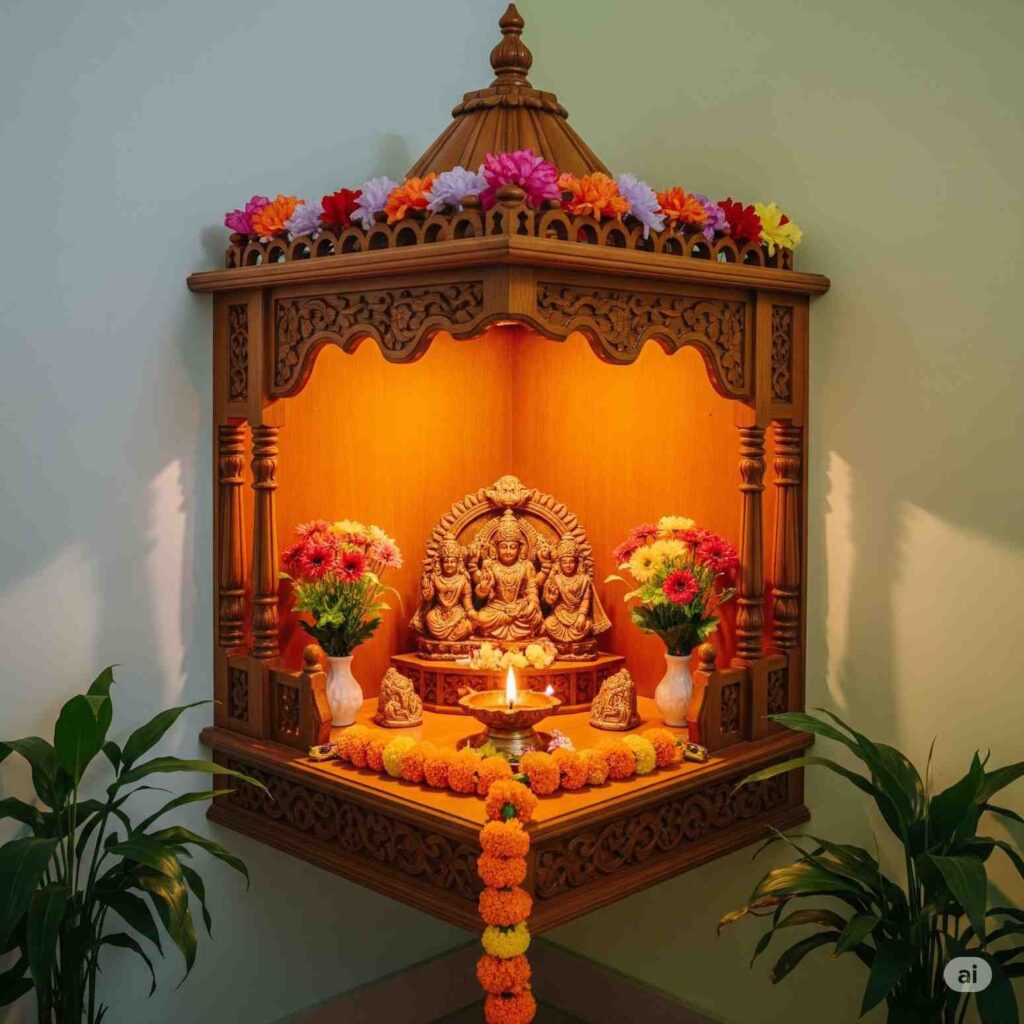
For modern homes with layout challenges, I’ve developed several adaptive strategies. Wall-mounted Mandir Designs with foldable shutters work beautifully in compact apartments while maintaining directional purity. I’ve also created successful installations using mirrors and lighting to redirect energy flow when structural limitations prevent ideal positioning.
The key insight I share with clients is that Vastu compliance doesn’t require rigid adherence to every guideline. Rather, it involves understanding the underlying principles of energy, light, and spatial harmony, then applying these concepts creatively within contemporary constraints. Most families find this balanced approach more practical and spiritually satisfying than either completely ignoring traditional wisdom or attempting impossible structural modifications.
5. Materials as Poetry: Opulence That Whispers Devotion
Material selection for Mandir Designs requires a delicate balance between durability, beauty, and spiritual appropriateness. I’ve learned this balance through both successes and expensive mistakes early in my career.
My preference for Makrana marble developed after witnessing its aging characteristics across multiple projects. Unlike synthetic alternatives that can yellow or stain over time, quality Makrana marble actually becomes more beautiful with age. I recently revisited a Pooja Room I designed eight years ago, and the marble surfaces had developed a subtle patina that enhanced rather than diminished their elegance.
Burma teak remains my preferred choice for altar construction due to its stability and natural resistance to moisture fluctuations. However, I’ve learned to educate clients about the initial investment versus long-term value. Premium teak might cost significantly more upfront, but I’ve never had to replace or refinish properly maintained teak elements, whereas cheaper alternatives often require attention within five to seven years.
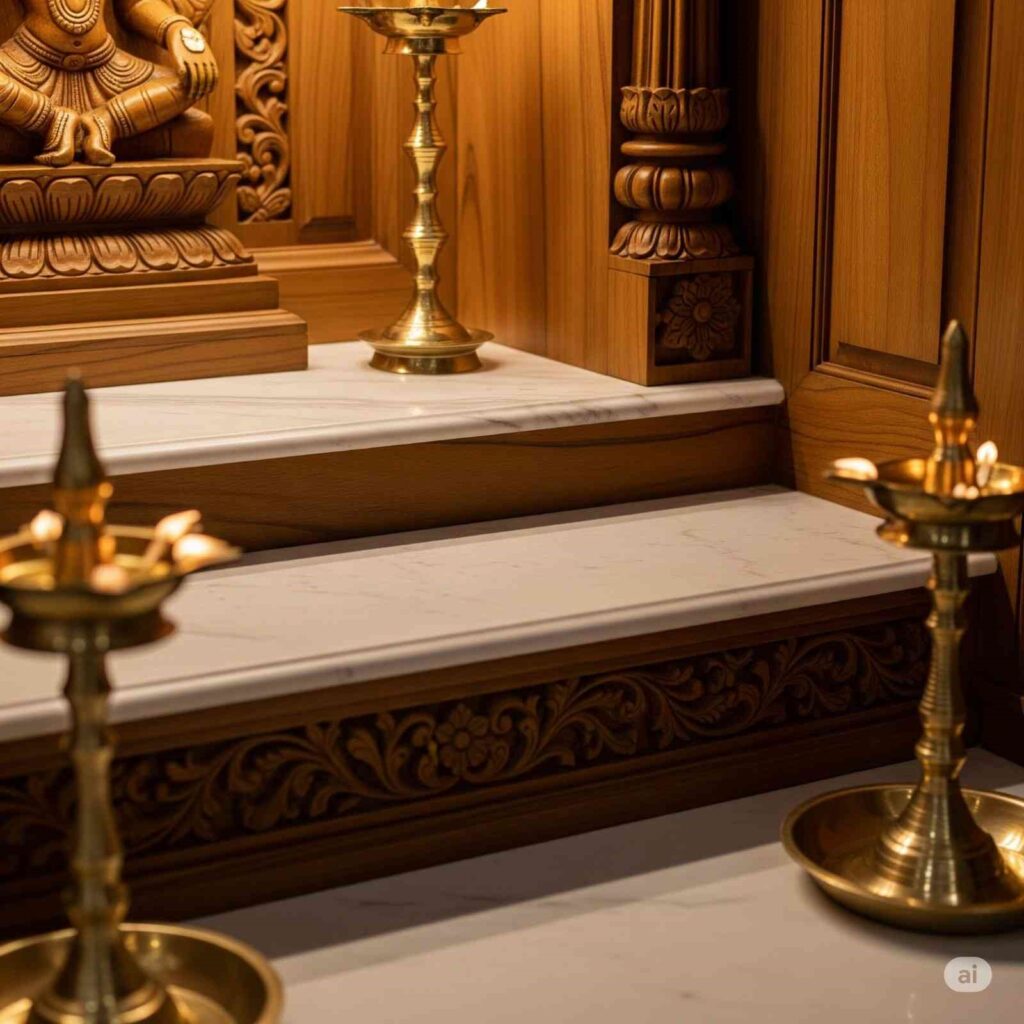
The brass elements deserve special consideration, particularly in coastal cities where humidity can cause rapid tarnishing. I now specify anti-tarnish brass alloys for diya holders and kalashas, which maintain their golden luster with minimal maintenance. This practical detail matters enormously to busy families who want their sacred space to remain beautiful without constant polishing.
Hand-cut jali screens present both opportunities and challenges. While machine-cut alternatives cost significantly less, I’ve found that hand-crafted screens develop character over time and allow for custom motif integration. A recent project featured jali panels incorporating the family’s ancestral symbols, creating a unique heritage connection impossible with standardized designs.
One material combination that consistently produces extraordinary results involves pairing Statuario marble with subtle gold-leaf accents. The veining in quality Statuario creates natural artistic patterns, while carefully applied gold highlights enhance rather than overwhelm the stone’s inherent beauty. These Pooja Room Designs often become family heirlooms that improve with age.
6. Illuminating the Divine: Light, Shadow, and Ambiance
Lighting design for sacred spaces requires understanding both technical aspects and spiritual psychology. I’ve spent considerable time studying how different light qualities affect meditative states and emotional responses during worship.
My layered lighting approach developed through observing traditional temple illumination methods. Ancient architects understood that divine figures should appear to glow from within rather than being harshly spotlit from external sources. I replicate this effect using concealed LED strips positioned behind translucent marble or frosted glass panels, creating gentle halos around deity niches.
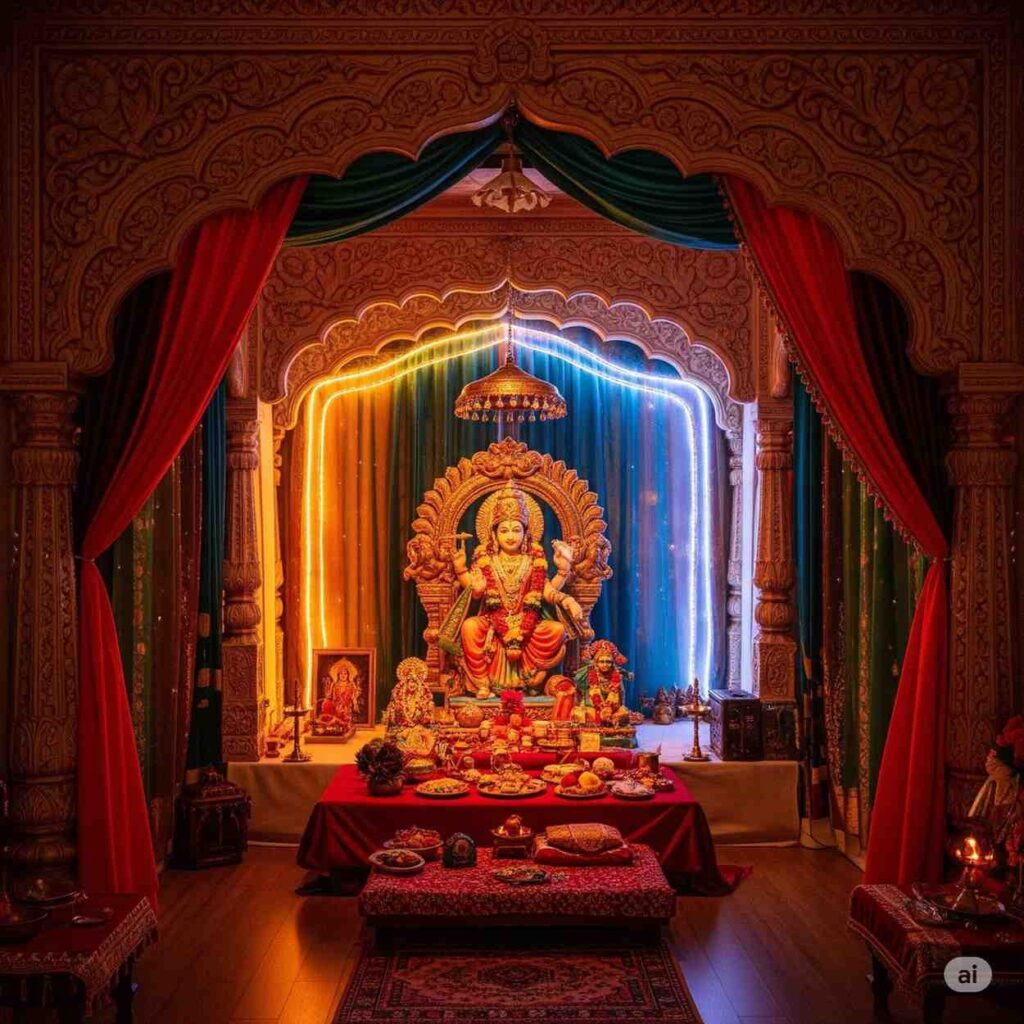
The color temperature selection proves crucial for maintaining appropriate ambiance throughout the day. I typically program systems to shift from warm golden tones during morning prayers (approximately 2700K) to cooler, more meditative blues during evening worship (around 4000K). This subtle transition supports the natural rhythm of daily spiritual practice while avoiding harsh fluorescent qualities that can disrupt contemplative moods.
One of my most successful lighting installations involved a Hyderabad villa where we incorporated skylights positioned to cast moving sun patterns across a marble Ganesha throughout the day. The family described watching these natural light dances as a form of moving meditation, transforming their Pooja Room into a living artwork that changes with the seasons.
Hidden electronic flame systems have become increasingly popular for families concerned about safety, particularly those with young children or elderly members. Modern LED flame technology creates remarkably realistic flickering effects while eliminating fire hazards associated with traditional oil lamps. I often combine these systems with motion sensors, so the “flames” automatically illuminate when someone approaches for prayers.
The programming capabilities of contemporary lighting systems allow for remarkable customization. Families can create preset scenes for different types of worship, festival celebrations, or quiet meditation sessions. One client programmed their system to gradually brighten during morning prayers, helping them transition gently from sleep to spiritual practice.
7. Bespoke Sanctuaries: Pooja Room Designs Tailored to You
No two families worship identically, which means standardized Mandir Designs rarely satisfy individual spiritual needs. I’ve learned to approach each project as a unique puzzle requiring custom solutions.
Compact apartments present particularly interesting design challenges. I recently worked with a Mumbai family living in a 650-square-foot space who desperately wanted a proper Pooja Room without sacrificing their already limited living area. We developed a sliding brass-mesh system that conceals their mandir within what appears to be a decorative wall panel. When opened, pull-out trays provide surfaces for thali preparation and flower arrangements, while vertical storage accommodates all their ritual essentials.
8. Elegante’s Signature: Where Heritage Meets Innovation
After fifteen years of designing sacred spaces, I’ve developed a reputation for blending traditional wisdom with contemporary innovation. This approach didn’t emerge overnight but evolved through countless conversations with families, collaboration with craftsmen, and continuous study of both ancient principles and modern materials.
My expertise combines formal training in interior architecture with specialized certification in Vastu Shastra principles. However, I’ve found that technical knowledge alone doesn’t create meaningful Pooja Room Designs. The real expertise comes from understanding how families actually use these spaces for daily worship, seasonal celebrations, and quiet contemplation.
The 2023 “Luxury Heritage Interiors” award recognized our work on a particularly challenging project that successfully integrated 18th-century architectural elements with cutting-edge climate control and lighting systems. This recognition validates our approach of honoring traditional craftsmanship while embracing beneficial modern technologies.
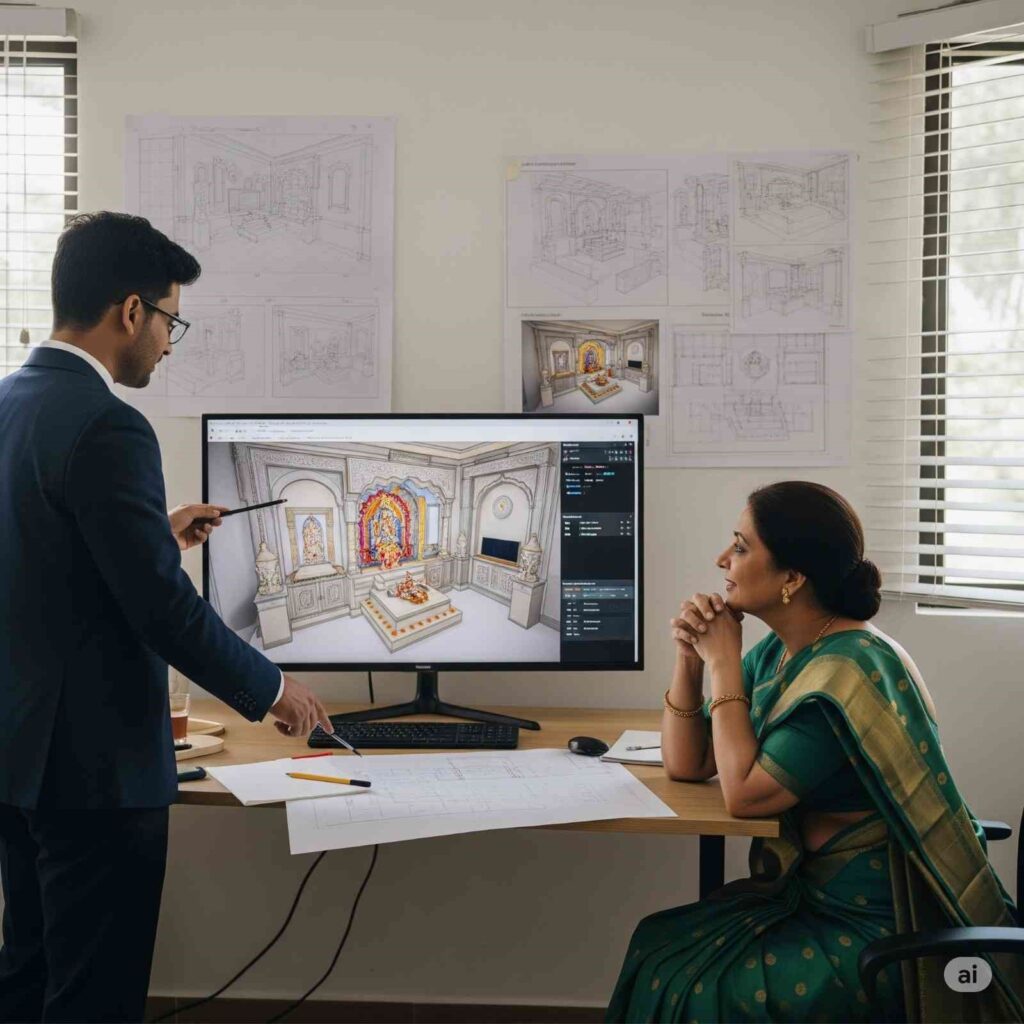
👉 [Begin Your Transformation with Elegante]
Ready to create a sacred sanctuary that reflects your spiritual journey? Every meaningful Pooja Room Design begins with understanding your unique worship traditions and aesthetic preferences.
I invite you to schedule a complimentary consultation where we’ll explore your vision for the perfect Mandir Design. During this conversation, we’ll discuss your space, spiritual practices, and design aspirations while reviewing examples of our completed sanctuaries.
Together, we’ll craft a sacred space that honors your heritage while embracing your lifestyle – a Pooja Room that becomes the spiritual heartbeat of your home for generations to come.
📞 Contact us for a free consultation or visit eleganteinterior.com to explore our portfolio!

